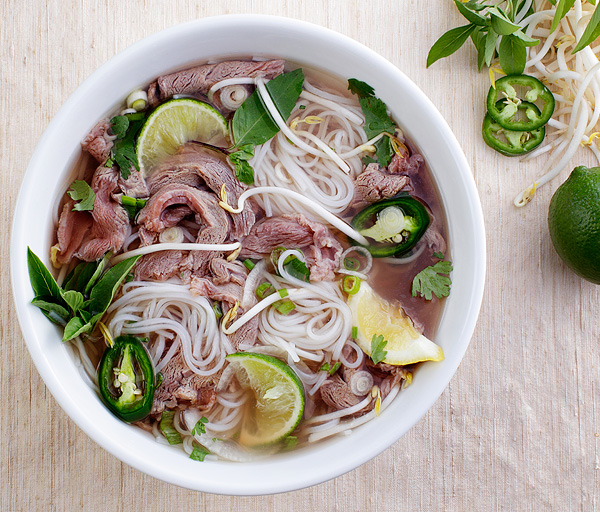You’re hung-over. Not you-regret-every-bad-decision-that-you’ve-ever-made-in-my-life-hung over, but you’re nowhere near sober. You’re hungry and nauseated. Your mouth feels dry. Your body aches, like an 87-year-old-participating-in-a-Spartan-Obstacle-Race-with-a-baby-elephant-tethered-to-your-back aches. You need sustenance, but looking at, even thinking, about heavy food makes your stomach churn angrily, and light food is not enough. You need a dish that is in rich in protein, that is full of electrolytes, and that has easy-to-digest carbs. There are a few dishes that possess these qualities, but the best delivery system for them, the dish that will set you right is the ubiquitous Vietnamese noodle soup: pho.
Lucky for you, your favorite Vietnamese restaurant is only a few blocks uptown from your apartment. You walk up 1st Ave. towards the restaurer, that’s French for “restore” and the word restaurant is derived from. The first restaurant opened in 1765 on the Palais-Royal in Paris. It served soup, which was meant to restore health.
An ambulance speeds past you; its siren pierces your ears like a pair of hot ice picks, as do the cab horns. A bike messenger speeds past you. His radio blasts music but you can’t make out the song. He’s too fast, and you’re too fatigued to distinguish lyrics. It’s just loud noise to you.
A block later, you see the green and red sign of the restaurer. You walk in and are seated at a dark hard wood table with a pair of padded metal chairs. The brick wall in front of you has a painting of a fishing village in Vietnam, five bamboo huts and three boats on a river. A dim light fixture hangs above each table. The waiter places a menu on the table and pours you a glass of water. He looks at you with just enough indifference to be comforting, butthe pounding in your head grows stronger. You need sustenance.
You open the menu to the middle and point to your usual: Saigon-style pho, the sweeter, less salty cousin of Hanoi-style pho. A moment later, the waiter returns with a large white bowl, which smells of menthol, smoke, and earth, in one hand and a jar of chili paste and a small plate of lime chunks, basil, and bean sprouts in the other hand. He disappears behind a long wooden counter next to the kitchen entrance. He reappears with a small stack of napkins and drops them onto the table.
Your pho is made to order by a pho-maker. She has three, maybe four, pots of broth going at once, and it’s good, too, a savory-sweet potion distilled from beef and chicken bones, and just enough cinnamon and cardamom to make it sweet but not too sweet. With good broth any ingredients can taste good, but with bad broth, even the best ingredients in the world couldn’t save it. The broth is dark but not too dark and not too light, either. On the surface float glistening globules of fat and marrow and a few Vietnamese beef meatballs, each one cut in half. A stack of thinly sliced pink, chewy beef eye round is added just before leaving the kitchen. The lean eye round sits half submerged—it will serve you well against the fatty broth and the translucent tendon that dissolve into fatty deliciousness with the slightest pressure—wilting, gradually turning grey as the broth cooks it.
You complete your pho yourself. You squeeze in a couple of lime chunks for sourness and add a dot—two at most—of dark red chili paste for heat. You take the disposable chopsticks with your right hand from the small plate and swirl the lime juice and chili paste in. You add dark green basil and white bean sprouts as needed. The basil acts like a palate cleanser, and the sprouts give a crunch, a freshness, a textural contrast to the rest of the dish. The goal is to get the perfect mix of beef, rice noodles, and broth in each bite.
In your mouth, a composition of tastes and textures: firm, tender, wet, slippery, chewy, savory, sweet, spicy, and umami. You hover over the bowl and slurp the rice noodles, which is acceptable, encouraged, when eating pho, and they’re right. Perfect, even. Not too soft, not too firm. A balance of the two. You sip the broth with the metal spoon in your left hand, and eat with the chopsticks in your right hand, the proper technique. The broth slides down your esophagus and into your stomach. Its warm life-giving property goes to work, healing your body after your night of heavy drinking. You wipe the snot dripping from your nose with the napkins. The bowl is encircled by sticky, crumpled paper balls, the visible expression of pleasure. You feel better, not quite restored, but you’re getting there.

Joseph Émile Bernard is a food writer living in New York. He is currently finishing his first novel and holds a BA in Writing from SUNY Plattsburgh and an MFA in Creative Writing from The New School. His work has been featured in The Inquisitive Eater. Follow him on Instagram: @notes_from_the_underbelly


Comments are closed.